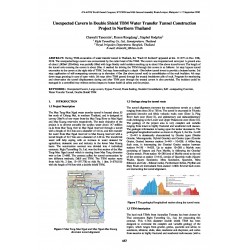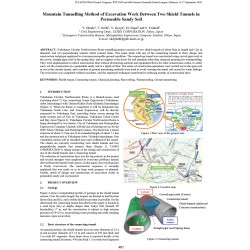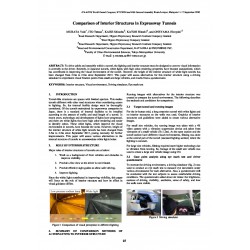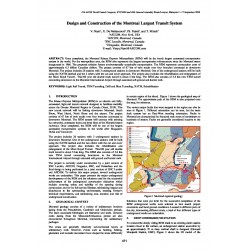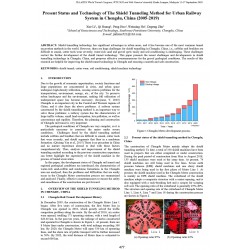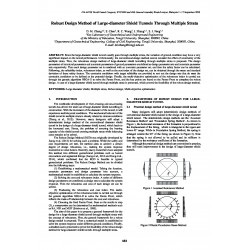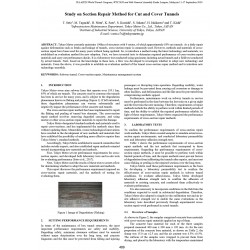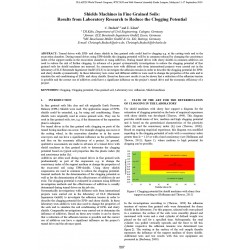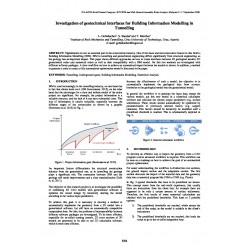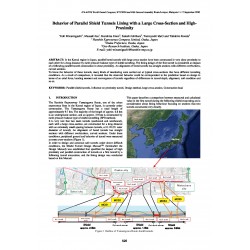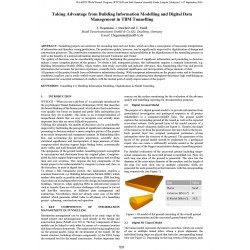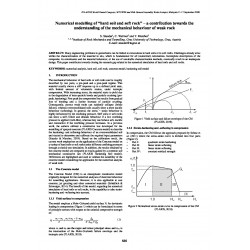No document
Search & filter
Search for a publication
Search & filter
World Tunnelling Congress
WTCThere are 1984 documents.
-
Unexpected Cavern in Double Shield TBM Water Transfer Tunnel Construction Project in Northern Thailand
Abstract: During TBM-excavation of water transfer tunnel in Thailand, the “Fault 26 Incident” appeared at km. 11+675 on Dec. 20th, 2018. The unexpected large cavern was encountered by the cutter head of the TBM. The cavern was inspected and surveyed. A ground area of about 1,800m² (50x40m), was partially filled with huge blocky rock boulders reaching up to about 10m above tunnel invert. The length of the...
0,00 € -
Investigation on Middle Flow Tunnel Lining Concrete Using Thickener-Containing Fluidizing Agent
Abstract: Japanese national expressway company known as NEXCO (Nippon Expressway Company ltd.) has developed mid-flow concrete to improve the workability and overall quality of secondary tunnel lining. This new concrete was standardized in July 2013. In recent years, it has become more popular to use mid-flow concrete with increased viscosity, which often is produced by utilizing thickenercontaining...
0,00 € -
Mountain Tunnelling Method of Excavation Work between Two Shield Tunnels in Permeable Sandy Soil
Abstract: Yokohama Circular Northwestern Route tunnelling project consists of two shield tunnels of about 4km in length and 12m in diameter, and two perpendicular tunnels which connect them. This paper deals with one of the connecting tunnels to show design and construction technique employed to overcome permeable ground condition. The connecting tunnel was constructed using curved pipe roofs at the...
0,00 € -
Comparison of Interior Structures in Expressway Tunnels
Abstract: To drive safely and smoothly within a tunnel, the lighting and interior structure must be designed to convey visual information is correctly to the driver. Recently, in Japanese tunnels, white lights with high color-rendering properties have become standardized, which has contributed in improving the visual environment of the tunnel. However, the height of the interior structure of white light...
0,00 € -
Design and Construction of the Montreal Largest Transit System
Abstract: Once completed, the Montreal Réseau Express Métropolitain (REM) will be the fourth largest automated transportation system in the world. For the metropolitan area, the REM also represents the largest transportation infrastructure since the Montreal metro inaugurated in 1966. The proposed solution fosters environmentally sustainable transportation. The REM represents construction costs of...
0,00 € -
Present Status and Technology of the Shield Tunneling Method for Urban Railway System in Chengdu, China (2005-2019)
Abstract: Shield tunnelling technology has significant advantages in urban areas, and it has become one of the most common tunnel excavation methods in the world. However, there are huge challenges for shield tunnelling in Chengdu, China, i.e., cobbles and boulders are difficult to smash, cutter tools wear severely, water-rich sand and gravel spew easily and soil conditioning is challenging. These...
0,00 € -
Robust Design Method of Large-diameter Shield Tunnels through Multiple Strata
Abstract: Since the large-diameter shield tunnel usually goes through multiple strata, the variation of ground condition may have a very significant impact on the tunnel performance. Unfortunately, the conventional design method cannot consider the effect of uncertainty of the multiple strata. Thus, the robustness design method of large-diameter shield tunnelling through multiple strata is proposed. The...
0,00 € -
Study on Section Repair Method for Cut and Cover Tunnels
Abstract: Tokyo Metro currently maintains 196km of structures with 9 routes, of which approximately 85% are tunnels. As a daily repair against deformation such as freaks and leakage of tunnels, cross-section repair is commonly used. However, methods and materials of crosssection repair have been used for many years without being updated. So, to introduce a method using the latest technology and...
0,00 € -
Lubrication of Pipejacking in Soft Alluvial Deposits under Impacts of Misalignment, Geology and Lubricant Injection Mode
Abstract: The impacts of the lubrication upon the pipejacking works has rarely discussed by literature. This study described a method that can be used to evaluate the lubrication performance by the reduction in the frictional coefficient μ as a function of injection type, soil and lubrication natures, and misalignment. The results of an application of the proposed method to a pipejacking project in the...
0,00 € -
Investigation into the Stabilizing Effect of Pipe Umbrellas
Abstract: One of the main hazard scenarios in tunnelling is ground instability in the excavation area, i.e. a collapse of the tunnel face and/or of the tunnel crown and walls over the unsupported span immediately after or during the excavation round. Pipe umbrellas are often applied to mitigate these risks of instability and thus to increase safety during construction. However, the increase in face...
0,00 € -
Shields Machines in Fine Grained Soils: Results from Laboratory Research to Reduce the Clogging Potential
Abstract: Tunnel drives with EPB- and slurry shields in fine grained soils could lead to clogging e.g. at the cutting tools and in the excavation chamber. During tunnel drives using EPB-shields the clogging potential will be in common reduced by changing the consistency index of the support media in the excavation chamber or using additives. During tunnel drives with slurry shields in common additives...
0,00 € -
The Challenge of TBM Push-through and Mine-through in Malaysia MRT Line 2
Abstract: During feasibility study and design stage of an underground subway, the common method of TBM crossing of intermediate station, i.e. push-through and mine-through, which basically can be affirmed for detail deign, however the changes of environment and condition of certain project, such as possession of land, unanticipated geological condition, work planning, operation actual situation of...
0,00 € -
Investigation of Geotechnical Interfaces for Building Information Modelling in Tunnelling
Abstract: Digitalisation is now an essential part in the construction industry. One of the latest and most innovative feature in this field is Building Information Modelling (BIM). BIM in tunnelling and geotechnical engineering differs significantly from structural engineering, as the geology has an important impact. This paper shows different approaches on how to create interfaces between 3D geological...
0,00 € -
Behavior of Parallel Shield Tunnels Lining with a Large Cross-Section and High-Proximity
Abstract: In the Kansai region in Japan, parallel bored tunnels with large cross-section have been constructed in very close proximity to each other for a long distance by earth pressure balance type of shield tunneling. The lining design of the first tunnel is considered an impact of a following parallel tunnel construction in close proximity. An alignment of bored tunnels has straight sections with...
0,00 € -
Taking Advantage from Building Information Modelling and Digital Data Management in TBM Tunnelling
Abstract: Tunnelling projects are notorious for exceeding time and cost limits, which are often a consequence of inaccurate interpretation of information and therefore wrong predictions. The prediction quality, however, can be significantly improved by digitalisation of design and construction processes. The contribution summarises the current instruments and possibilities in the digitalisation of the...
0,00 € -
Numerical Modelling of "Hard Soil and Soft Rock" - A Contribution towards the Understanding of the Mechanical...
Abstract: Many engineering problems in geotechnics can be linked to excavations in hard soils or in soft rocks. Challenges already arise within the characterization of the material in situ, which is fundamental for all (numerical) calculations. Incomplete descriptions of the composite, its constituents and the material behaviour, or the use of unsuitable characterization methods, eventually result in an...
0,00 €

